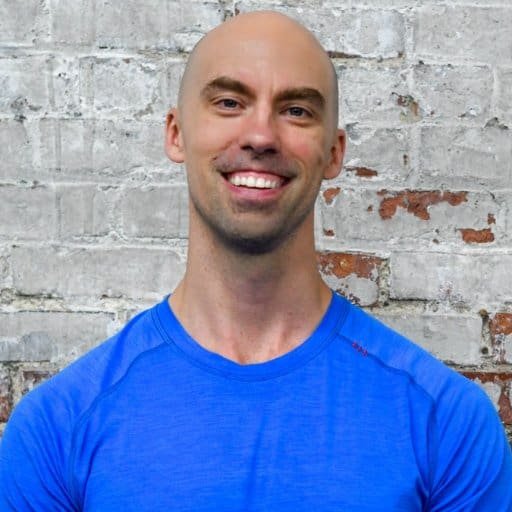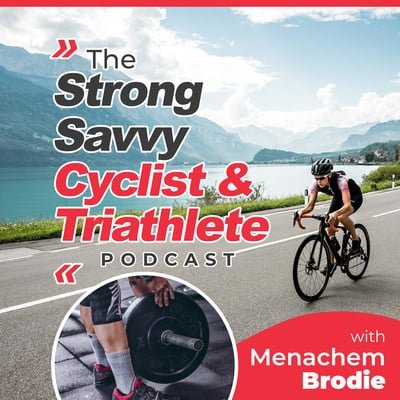Tony Gentilcore is not only a great guy, but he’s also been around the strength game for quite some time. When he’s not writing his Pulitzer(ish) award winning blog, he’s helping people get stronger, fitter and faster…. And today, we get to pick his brain and kick around some important topics as it pertains to endurance athletes.
In part 1 of our conversation we talk about “Complimenting your other training”, what topic leaves people with “The Largest Eyeroll In History”- but why it’s absolutely integral to success, and much, much more!
In this Episode:
- Tony Gentilcore
- Shoulder Significance
- Positioning
- Breathing Mechanics
- Mid-back
- Entertainment Value of Strength Training Exercises
- Importance of Breathing
- Core Control and Stiffness
- Posture and Positioning
- Consistency
- Conclusion
Show Notes:
1:00 –
Tony Gentilcore
- He is a gifted writer and leading strength training coach
- Check out his blog and sign up for his newsletter
- His partner is Dean Somerset and together they constructed The Complete Shoulder and Hip Blueprint – versions 1+2
- Also loves his cat 🙂
- He has worked in a number of different settings and has a wide array of knowledge, but in this episode, we’ll focus specifically on the shoulder and deadlifts, tied together with the spine
- Tony is also known as Menachem’s “Stu McGill”
5:17 –
Shoulder Significance
- Integral for breathing, positioning, and keeping things working the way they need to
- “I’ve worked with mostly recreational cyclists” – Tony
5:42 –
Positioning
- Cyclists are in a flexed (rounded kypothic posture) position for long periods of time in which the shoulders tend to be more internally rotated, anteriorly tilted, and abducted with their shoulder blades, with the upper back rounded
- “The body is going to adapt to the positions it’s in the most” -Tony
- Trigger point – pecs will be tight, bicep tendon will be aggravated, back side weaker (rhomboids, traps, erectors) – everything will be elongated/stretched
- The back will therefore probably need to be strengthened, and the front side would need to be loosened up
- “Grind area”: lat, teres, long head of the tricep all bunched up together – problematic for a lot of people to safely bring their arms overhead
- “I am a big fan of using a lacrosse ball, a foam roller – I like the action mobility ball” – Tony
- This will help cyclists get better in that It’ll help them to not get hurt
- Eric Cressey – “niggles” – things that don’t feel right/hurt
- This will help cyclists get better in that It’ll help them to not get hurt
- “It’s very important to keep your tissue quality in check” – Tony
- “It’s not just strength that we’re after – it’s time under tension – the ability to produce intra and inter muscular coordination at the right times and being able to move” – Menachem
- A lot of people don’t understand this yet, but this is the intention of the lacrosse ball exercise
- Lats = strongest internal rotator of the shoulder
- In the lacrosse ball exercise, when we open up the teres minor and the lats, it helps get the chest a little bit lower and makes you more aerodynamic, which helps breathing patterns
- A lot of people don’t understand this yet, but this is the intention of the lacrosse ball exercise
- What are some of the considerations that we need to think of with the shoulders and being in that position for so long?
- Most issues are dealing with the back side, like the rotator cuff
- Typically, the culprit is the shoulder blades
- Tony wants to see scapulohumeral rhythm, the ability to lift arms overhead, and rotation of the shoulder blades in assessment
- The shoulder blade has to do 3 things to bring the arm up overhead:
- Most issues are dealing with the back side, like the rotator cuff
- Upwardly rotate
- Posteriorly tilt
- Protract
12:50 –
Breathing Mechanics
- Breathing mechanics and 3D expansion has a lot to do with it
- The shoulder blades are at the mercy of the rib cage
- You need to be able to move the rib cage to get the good canister position
- Get rib cage down on an exhale and stack the diaphragm and pelvic floor
- When people do this incorrectly and start using secondary methods to breathe they tend to complain of headaches
- You need to be able to move the rib cage to get the good canister position
- Counternutation and nutation of the pelvis and how it affects the shoulder
14:56 –
Mid-back
- Mid-back – mid and lower traps and rhomboids
- Protraction – where the shoulder blades come forward and out on the rib cage
- Upward rotation – shoulder blades scoop up and out
- We want to strengthen the scapular retractors and downward rotators (rhomboids)
- When they’re over-active, and you can’t get protraction, it will effect back and shoulder health, and then you have to re-train people to do push-ups, rows, etc.
- As we straighten out the arm for a row, the shoulder blade should move around the rib cage and not just stay in that retracted position
- Cervical extension position for so long can give you the “adam’s apple” forward head posture – jutting head out
- The lats and lower traps have the same fiber orientation as far as the degree of pennation of ~135º
- “If the lats over-dominate, the lower traps have a hard time doing their job” – Tony
- Prone trap raise improves the posterior tilt of the scapula
- When they’re over-active, and you can’t get protraction, it will effect back and shoulder health, and then you have to re-train people to do push-ups, rows, etc.
19:59 –
Entertainment Value of Strength Training Exercises
- A lot of people go for what’s hot and new, but just stick with the basics!
- “Fitness trends” aren’t really a thing for either Tony or Menachem
- “I’m a simpleton” – Tony
- “Everything ties together” – Menachem
- So it’s okay that we go off track a little in the podcasts
- Lower traps and prone trap raises
- Two exercises by Tony:
- Prone one-arm trap raise – people use their hand and not a lot of weight
- It may not be new, but you need to review the basics and then you can do something new
- Prone one-arm trap raise – people use their hand and not a lot of weight
- Two exercises by Tony:
- Triathletes and cyclists always want to do stuff on Indo board, Bosu board, etc.
- “We get very infatuated by what elite athletes, triathletes, NBA players, powerlifters, Olympic lifters, what they’re doing now, but no – the question to ask is what they were doing ten, fifteen, twenty years ago” – Tony
- “They’ve earned the right to do that stuff… you’re not LeBron James” – Tony
- “We’re very enamored by bright, shiny objects” – Tony
- It’s important to keep athletes grounded
- “I’ll be the first to admit – I’m not very sexy with the exercises I use, or the assessments I use, or the programs I write – I know they work” – Tony
- There is a little bit of an entertainment value with corrective exercises and basic strength and conditioning – some people just get bored and don’t like doing the same thing repeatedly
- There’s a degree of professionalism that comes with having your shirt on or off in filming things
- Even though it may look cool and attractive, having your shirt off doesn’t give you more credibility
- “The fundamentals remain fundamentals” – Menachem
- Most triathletes and cyclists are gen. pop when it comes to their ability in the weight room
- Most people get hurt in the weight room because they’re lifting weights that are too heavy because they think they can
- “I find that female athletes don’t have an ego – and if you tell them to take weight off the bar they don’t care – they’d rather do it correctly” – Tony
- “We get very infatuated by what elite athletes, triathletes, NBA players, powerlifters, Olympic lifters, what they’re doing now, but no – the question to ask is what they were doing ten, fifteen, twenty years ago” – Tony
33:03 –
Importance of Breathing
- As soon as people talk about breathing (with gen. pop or athletes) their eyes roll, but the position of the canister is so important for movement
- PRI: postural restoration institute – champions most of the breathing stuff we latch onto
- Dr. Evan Osar – breathing mechanics – 2006 or 2007
- Dr. Sarah Duvall – diaphragm, pelvic floor, specifically post-partum
- Breaks down the mechanics to make a lot of sense
- At Cressey Sports Performance, where Tony once worked, they toned down the eye rolls when teaching breathing
- They’d do 5 or 6 breathing exercises that they liked for the program:
- Gets them into more flexion with the shoulders and diaphragm in better position
- Do 10 breaths total to get people in better position and then they can go train in that position
- They’d do 5 or 6 breathing exercises that they liked for the program:
- Drills done with a baseball player would be different from drills done with a cyclist – same concept of getting them into canister position though
- Cyclists wouldn’t be in bear stance on all fours in flexed position
- They’d do more deadbugs, sphinx pose, side lying position, or sit in 90º stance against wall, breathe into the back, push back into wall as you expand ribcage and exhale
- Cyclists wouldn’t be in bear stance on all fours in flexed position
37:33 –
Core Control and Stiffness
- Important to improve/build proximal stability – midline/core – to improve distal mobility
- “Force creates motion, but stiffness allows you to have control” – Menachem
- If you have proximal stiffness and control, then you can produce more force in the right direction
- Nutation and conutation are so important here
- “Joint position dictates muscle function” – Menachem
- How the acromion sits is important
- With breathing, the sternum lifts up like a water pump, which is important for cyclists to understand
- For cyclists, you need belly breathing, but the rest of the time you want to do more chest/mid-back breathing
- With breathing, the sternum lifts up like a water pump, which is important for cyclists to understand
- How the acromion sits is important
43:04 –
Posture and Positioning
- “Don’t put all your eggs into the postural basket” – Tony
- Don’t assume that if someone has bad posture they’re gonna fail
- “Static posture – static positioning – can give you some insight on why their shoulder may be hurting” – Tony
- Important to look at static presentation and add movement
- “This position” Tony is referring to is his arm overhead next to his ear, with proper spacing, while crouched forward
- Tony’s job is to offset risk as much as possible, which is where breathing comes in
- “If you’re hurt, you can’t compete, if you’re hurt, you can’t train, so that’s why we do this shit” – Tony
47:39 –
Consistency
- “Consistency is paramount” – Tony
- It comes down to strength training and how consistent you are with it
- “Easy training is good training” – Tony
- One of Tony’s new clients came from more of a cross fit background in which the mentality is all or nothing, but they do get people to understand what hard work is
- “I want you to leave a session thinking that you can do more – most of the time” – Tony
- Paul Carter – 80% workouts
- 10% of the time you walk into the gym you will feel amazing and hit PRs
- 10% of the time you feel like garbage
- You want the 80% workouts – get your reps and sets in and get out
- Consistency here leads to improvement
- Easy = 5,6 & 7 RPE out of 10
- “Consistency trumps everything” – Tony
- HTFU – Harden The Fuck Up
- Menachem was against this
- The minimum you should do is your warmup and soft tissue work, if you need to drop the weight down, you can
- “Getting into the gym and staying/keeping that pressure is like investing” – Menachem
- If you keep investing it will have a greater effect over time, and most people don’t understand this until they hit their own tipping point
- 2 book recommendations:
- If you keep investing it will have a greater effect over time, and most people don’t understand this until they hit their own tipping point
- “I Will Teach you to be Rich” – Ramit Sethi
- “The Compound Effect” – Darren Hardy
55:30 –
Conclusion
- Main themes:
- Offsetting the risks
- Every day should not be 100%
- 80% rule
- Stay consistent
- Like, subscribe, and share!











